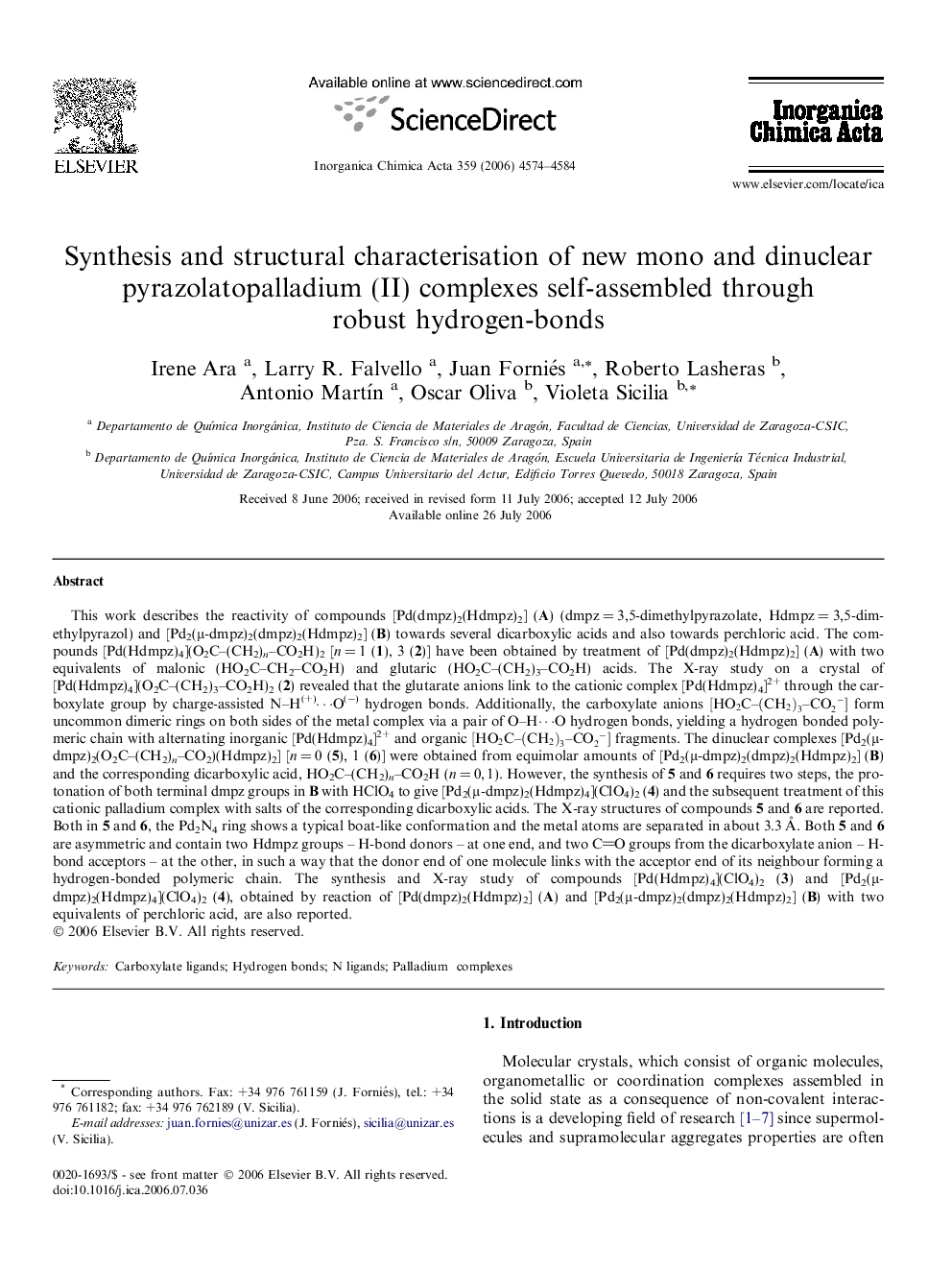| کد مقاله | کد نشریه | سال انتشار | مقاله انگلیسی | نسخه تمام متن |
|---|---|---|---|---|
| 1312829 | 975502 | 2006 | 11 صفحه PDF | دانلود رایگان |

This work describes the reactivity of compounds [Pd(dmpz)2(Hdmpz)2] (A) (dmpz = 3,5-dimethylpyrazolate, Hdmpz = 3,5-dimethylpyrazol) and [Pd2(μ-dmpz)2(dmpz)2(Hdmpz)2] (B) towards several dicarboxylic acids and also towards perchloric acid. The compounds [Pd(Hdmpz)4](O2C–(CH2)n–CO2H)2 [n = 1 (1), 3 (2)] have been obtained by treatment of [Pd(dmpz)2(Hdmpz)2] (A) with two equivalents of malonic (HO2C–CH2–CO2H) and glutaric (HO2C–(CH2)3–CO2H) acids. The X-ray study on a crystal of [Pd(Hdmpz)4](O2C–(CH2)3–CO2H)2 (2) revealed that the glutarate anions link to the cationic complex [Pd(Hdmpz)4]2+ through the carboxylate group by charge-assisted N–H(+)⋯O(−) hydrogen bonds. Additionally, the carboxylate anions [HO2C–(CH2)3–CO2-] form uncommon dimeric rings on both sides of the metal complex via a pair of O–H⋯O hydrogen bonds, yielding a hydrogen bonded polymeric chain with alternating inorganic [Pd(Hdmpz)4]2+ and organic [HO2C–(CH2)3–CO2-] fragments. The dinuclear complexes [Pd2(μ-dmpz)2(O2C–(CH2)n–CO2)(Hdmpz)2] [n = 0 (5), 1 (6)] were obtained from equimolar amounts of [Pd2(μ-dmpz)2(dmpz)2(Hdmpz)2] (B) and the corresponding dicarboxylic acid, HO2C–(CH2)n–CO2H (n = 0, 1). However, the synthesis of 5 and 6 requires two steps, the protonation of both terminal dmpz groups in B with HClO4 to give [Pd2(μ-dmpz)2(Hdmpz)4](ClO4)2 (4) and the subsequent treatment of this cationic palladium complex with salts of the corresponding dicarboxylic acids. The X-ray structures of compounds 5 and 6 are reported. Both in 5 and 6, the Pd2N4 ring shows a typical boat-like conformation and the metal atoms are separated in about 3.3 Å. Both 5 and 6 are asymmetric and contain two Hdmpz groups – H-bond donors – at one end, and two CO groups from the dicarboxylate anion – H-bond acceptors – at the other, in such a way that the donor end of one molecule links with the acceptor end of its neighbour forming a hydrogen-bonded polymeric chain. The synthesis and X-ray study of compounds [Pd(Hdmpz)4](ClO4)2 (3) and [Pd2(μ-dmpz)2(Hdmpz)4](ClO4)2 (4), obtained by reaction of [Pd(dmpz)2(Hdmpz)2] (A) and [Pd2(μ-dmpz)2(dmpz)2(Hdmpz)2] (B) with two equivalents of perchloric acid, are also reported.
The compounds [Pd(Hdmpz)4](O2C–(CH2)n–CO2H)2 and [Pd2(μ-dmpz)2(O2C–(CH2)n–CO2)(Hdmpz)2] have been prepared and they show the capability of self-assembly to generate hydrogen bonded polymeric structures.Figure optionsDownload as PowerPoint slide
Journal: Inorganica Chimica Acta - Volume 359, Issue 14, 1 November 2006, Pages 4574–4584